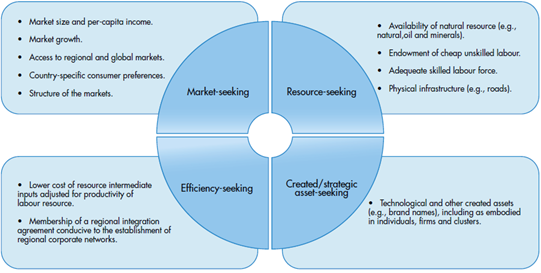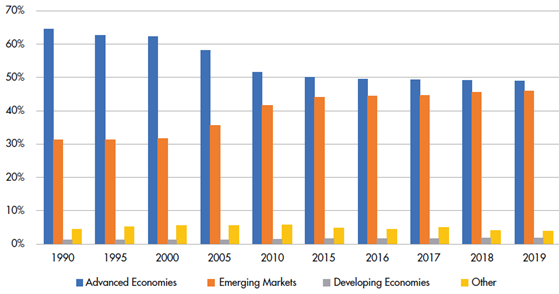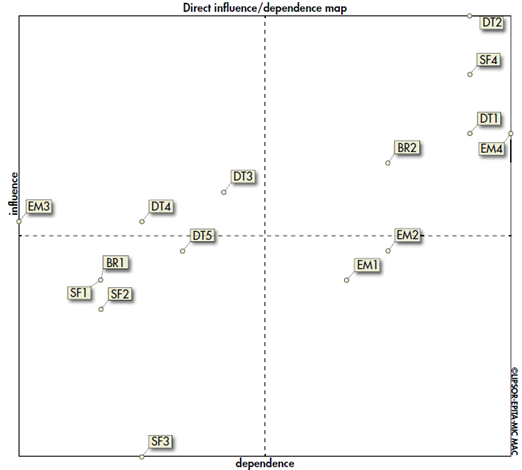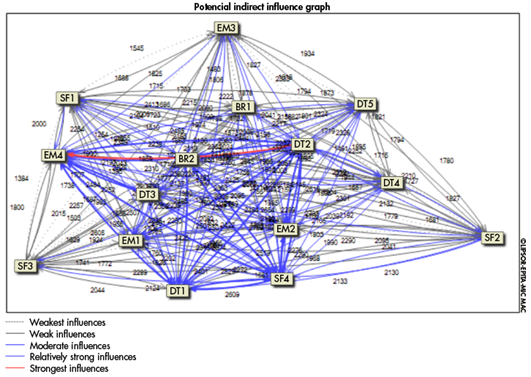1. Introduction
Nowadays, enterprises are more interested in discovering the business environment more precisely and how they are connected to the global network to bear the rapid change of the worldwide market (Aarikka-Stenroos & Ritala 2017). Many enterprises cannot stand the uncertainty by which a variety of environmental changes happen. A majority of business organisations managers lack strategic insights and flexibility to encounter uncertainty, which in turn, making difficult to achieve business goals and causes a massive financial shortage and going to be insolvent (Arokodare & Asikhia, 2020). Lacking the ability to perceive changes such as increasing technology development, consumer demands, accelerating innovation pace leads an organisation to misunderstand those items (Rohrbeck, 2010). In addition, digital transformations undoubtedly affect the whole market and enterprises on an international scale. Companies should figure out digitalisations long-term challenges and adjust themselves to these transformations. To gain this goal, enterprises can elaborate on a digital strategy that results in a comprehensive perspective and ensures their survival in the digital era.
Strategic futures studies would be efficient to capable enterprises of estimating the circumstances rapid change. Concepts like future studies and learning organisations are ingrained in how organisations can deploy new information to be more dynamic since these items are necessary for an organisation to how data is deployed in decision-making processes (Pulsiri & Vatananan-Thesenvitz, 2021). Appropriate future studies would strengthen businesses to identify the worldwide changes, recognise a wide range of development, and lead them to employ a variety of technics regarding the changes (Sarpong & Maclean, 2011). According to the strategic futures studies capacities, nowadays, many organisations are prone to implement these features to achieve a sustainable competitive advantage to pave the way for further accomplishments (Vecchiato, 2015).
This study is conducted to consider effective driving forces and how they affect entrepreneurial resiliency in the face of uncertainty to increase an enterprises productivity and efficiency based on employing digital development in emerging enterprises. More specifically, this study aims to present a strategic future study in entrepreneurial resiliency considering digital development trends in emerging markets.
2. Literature Review
2.1 Strategic Futures Studies
Rapid changes in business markets are increasing and leading businesses to be more competitive. An organisation must adapt to these changes, whether by adjusting to those changes or gaining new capabilities (Vecchiato, 2015). Due to environmental complexity and rapid changes, Organisations require a novel strategic design method and change management to make up their preferable future. Therefore, organisations can accommodate the competitive environment by deploying future studies and predicting future transformations (Sarpong et al., 2019). Foresight is a multidisciplinary field encompassing a range of approaches like complexity and uncertainty. Its purpose is to discover alternative plans for forecasting emerging changes. Future studies aim to devise, consider, evaluate and suggest the possible future to raise peoples awareness of the current changes (Bell 1997, 73 ).
Strategic futures studies notice the unpredictable future and have the potential skill to exploit opportunities from limitations (Sarpong et al., 2019). Strategic futures studies present solutions toward the unstable environment and analyse those emerging situations (Vecchiato, 2015). Strategic foresight observes and determine different variable responsible for changes and can detect possible outcomes (Rohrbeck & Schwarz, 2013). It comprises surveillance, learning, and forecasting apparent trends (Inkinen & Kaivo-oja, 2009). Also, it focuses on long and short-term goals called path changes and model recognition (Mavengere, 2013). Some studies prove that future studies can make a superior vision for managers to overtake the market and go beyond the borders to be more significant than their peers (Chia, 2008; Gabriel, 1995). Strategic futures studies have the potential to boost "planned learning processes" by which managers could have a preferable perspective for understanding the business environment on a large scale." Planned learning process" means that managers do not have to predict the future; however, they must do the reaction in a way that is compatible with environmental business features (Vecchiato, 2015).
There is an increasing awareness of the essential role of strategic futures studies in contemporary organisations. Thus, foresight scholars suggest an insight into the historical, institutional, and intellectual context in which human reaction is formed in complex environments (Son, 2015). Similarly, researchers believe that strategic foresight is inextricably linked to learning processes (Bootz et al., 2019). Learning is a process to produce and utilise new knowledge to improve performance and is considered an dynamic approach by which an organisation can adjust to the rapid changes, and consequently, result in consistent improvement (Cunliffe, 2008). If strategic futures studies are deployed, the organisation will expect to gain: 1-perception, 2- the ability of interpretation, 3-the ability to respond to solve problems, which totally improves organisational learning capacity, and this organisation have superior value compared to its peers. In other words, learning in business is a dynamic process that causes an organisation to adjust to changes at a high pace and enriches its quality (Rohrbeck & Schwarz, 2013). How to deploy the future studies and integrate it with daily operations is required an appropriate system for organisational learning (Rhisiart et al., 2015).
2.2 Entrepreneurial Resiliency
Entrepreneurial resiliency is a significant concept to encounter with crisis; indeed, it is an organisational characteristic to deal with a variety of problems (Coles et al., 2021; Amankwah- Amoah et al., 2021). The idea of resiliency is deployed in a broader context of knowledge. It refers to the capacity of an element to return to a sustainable situation. Organisational resiliency is the companys ability in crisis management and escapes from a challenging situation (Mishra & Zachary, 2014; Beuren et al., 2021).
The concept of resiliency is divided into two sections: static resiliency and dynamic resiliency. Static resiliency refers to the ability to preserve business consistency, and dynamic resiliency is about how fast a business could return to a favourable position (Rose, 2007). Resiliency affects business performance and job satisfaction, and research reveals that resilient companies have superior performance to non-resilient ones (Hillmann & Guenther, 2021). Resiliency promotes effective reactions to the environment and supports a wide range of organisational capabilities (Lengnick-Hall et al., 2011). Organisational resiliency refers to achieving new abilities, increasing supervisory skills, and making new opportunities. Similarly, scholars believe that organisational resiliency is a dynamic process in which corporate members (staff) display positive accommodation, fortifying organisational advantages in a crisis (Hameed et al., 2021; Pereira et al., 2021; Salamzadeh & Dana 2021; Vorobeva & Dana, 2021; Young, 2021). Entrepreneurial resiliency aids organisational performance in crisis due to handling times of uncertainty (Lee et al., 2013; Hanson & Keplinger, 2020).
Studies define resiliency as a dynamic ability of an organisation associated with individuals, teams, and subsystems linked to immediate changes in various circumstances and how to respond to those changes (Werner et al., 2021). Resiliency is the ability to respond to crises and uncertainty and positively affects business performance (Ali et al., 2021). Resiliency is an organisations potential capacity to extend its supplies and identify opportunities for increasing competitive privilege. Resiliency specifically reflects effective crisis management processes to cooperate, share information, and common feelings in crisis management literature. Staff interactions have of the importance in resiliency existed in an organisation (Young, 2021). Therefore, the level of resiliency affects business development on both individual and organisational scales (Pathak & Joshi, 2021). Entrepreneurial resiliency could be divided into two sections: (i) facing with facts then accepting them, and (ii) predicting business circumstances (Saylors et al., 2016).
2.3 Digital Technology Development
Information and communication technology (ICT) is the primary reason for economic growth. ICT supports enterprises to be of as much as competitive and stimulates them to economic development. In case that resources or initial funding is limited, ICT development would be the most efficient path to gain social welfare. Thus, ICT clustering is a new method for being more competitive based on human resources (Andreev et al., 2019). There is a common belief that digital technology causes companies to alter business models quickly (Warner & Wäger., 2019). Digital transformation is defined as enterprises initiative for deploying novel equipment to change strategies and operations (Li, 2020). Digital technologies provide a variety of abilities that could not be imagined in the past, including G5, Artificial intelligence (AI), or 3D printers (Dubey et al., 2019). Regarding that, the time between emerging a piece of digital equipment and using them has become much shorter, so it is not easy to estimate the course of digital trends and development. Organisations should recognise external stimuli and use digital technology to be prepared against those drivers (Gupta & Bose, 2019; Li, 2020).
Enterprises of different sizes use digital transformation regarding their objective background, summarised in three paths. First, high-matured enterprises of small and medium sizes respond to changes by digitalisation as fast as possible. Second, some enterprises with financial problems but a low-level understanding of digital transformation decide to use digital strategy in sales items. Third, enterprises with minimal digital transformation knowledge but a wide range of social supports (Priyono et al., 2020).
The conceptual definition of digital transformation (DT) consists of five primary activities by which enterprises can respond to their environment, including Big Data (BD), Artificial Intelligence (AI), Internet of Things (IoT), Smart Factories (SF), and Cyber-Physical Systems (CPS) (Imran et al., 2018). They implement those facilities in their infrastructure and services or to solve their practical problems (Santalova et al., 2019).
2.4 Emerging Markets
When scientific research began about emerging markets, the world was going through rapid growing markets in Eastern Asia, Latin America, Southern Asia, and Eastern Europe. Nowadays, these economies with rapid changes are followed by international enterprises and individual entrepreneurs. They spot opportunities in these countries and represent financial resources and their potential markets for international funders. Emerging Markets (Ems) are potentially young enough to present a proper demand for products or services among middle-class and populated-urban areas. These zones also are popular for those businesses which are pursuing growth opportunities. Many new enterprises are emerging from those markets and are growing to be part of the international markets (Cavusgil, 2021). Growing emerging markets (Ems) are prominent in some countries like China, Brazil, Southern Africa, India, Russia, and Turkey, making them the best spots to invest (Holtbrügge et al., 2015). Direct investment activities are comprised of four items based on motivation (Dunning, 2000; UNCTAD, 2006): (i) market research, (ii) resource research, (iii) outcomes research, and (iv) strategic research. Therefore, enterprises choose the appropriate place for funding regarding these features to dedicate their money to them (Pradhan, 2010).

Source: Authors figure based onUNCTAD (1998)
Figure 1 Motivations of FDI and host country economic determinants.
Emerging markets fairly had constituted 30% of the worlds GDPs in 1990, but now they primarily make up 42% of the worlds GDPs and 55% of the whole world population. Figure number 2 refers to the importance of the emerging markets in advanced economies compared with developing countries.
3. Methods
In this paper, the meta-synthesis approach has been exploited to identify the driving forces and other related factors by considering four main areas: (i) strategic futures studies, (ii) entrepreneurial resiliency, (iii) digital technology development trend, (iv) emerging markets. Next, a questionnaire was deployed to analyse the most related concepts specifying the priority of the ideas using the Delphi method and SPSS software to determine the associated concepts playing the most prominent role in this study. Then, the result was considered with the aid of experts, and consequently, a cross-impact analysis matrix was employed to implement a structural analysis to determine the meaningful link between the present and future factors using MicMac2 software. Therefore, the method of this study is descriptive-analytic, comprising mata-synthesis in theoretical section and questionnaire in analytics section, and regarding the application of this study in operations, it could be considered a practical study (Dana & Dana, 2005).
As mentioned above, a researcher-made questionnaire is used to collect data (Dana & Dumez, 2015). The questionnaire comprises fifteen driving forces drawn on strategic futures studies in entrepreneurial resiliency considering digital development trends and emerging markets. Regarding these four aforementioned factors and examining the literature review in these areas by meta-synthesis, and then investigating experts opinions, a questionnaire was prepared and given to experts. Experts were fifteen individuals among the prominent universities professors whose major is business administration and future studies.
The questionnaire aims to emphasise the possibility of driving forces in the primary areas mentioned above. The Likert scale was approached to measure the answers in multiple-choice items, which was:1- very low importance, 2-low importance, 3-moderate importance, 4-high importance, and 5-very high importance. Delphi method was employed to analyse the questionnaire by using the SPSS. Also, the cross-impact analysis matrix numbers were 0, 1, 2, 3, and P for determining the rate of being effective or being affected. The 0 to 3 were deployed to analyse the cross-impact effects, and the P symbol for considering the potential effects was used. Consequently, The result of the analysis was imported into the MicMac software to determine the status of driving forces.
The Delphi technique was devised by Kahn and Wiener (1967) and his colleagues to use experts attitudes toward a specific subject. In this method, a questionnaire is distributed among a panel of experts; then, their attitude is gathered in several stages and being revised at each level. This method is a social approach to the possible events of future or developments. Besides, the MicMac software was devised by Duperrin and Godet (1973) to analyse the direct proportion among variables which also considers the undirected link between sections. As a result, variables are divided into four categories: (i) including independent variables with less effectiveness and dependency, (ii) dependent variables with less effectiveness, but are of most dependency, (iii) linked variables with the most stimulative effect and dependency, (iv) this group consist of independent variables having stimulative effects, but of less dependency (Dubey & Ali, 2014). Using of MicMac software is common among project management and engineering. For instance, Bredillet (Bredillet et al., 2018) had exploited this method for discovering cross-links that existed in project management offices. MicMac analysis is composed of these items: (i) discovering interactions among variables, (ii) making a matrix, (iii) drawing the network, (iv) identifying the most influential variable, and (v) qualitative and quantitative analysis on the interactions. Table 1 shows the participants demographic information.
Table 1 Demographic information.
| Frequency | Percentage | |
| Panel A: Sex | ||
| Female (Male) | 5 (10) | 25.00% (75.00%) |
| Panel B: Age | ||
| 30-37 years old | 1 | 6.50% |
| 38-44 years old | 7 | 47.00% |
| 45-51 years old | 6 | 40.00% |
| 52-58 years old | 1 | 6.50% |
| Panel C: Education | ||
| Master | 0 | 0.00% |
| PhD | 15 | 100.00% |
| Panel D: Work experience | ||
| 5-10 years | 3 | 20.00% |
| 11-15 years | 5 | 34.00% |
| 16-20 years | 6 | 40.00% |
| 21-25 years | 1 | 6.00% |
3.1 Validity and Reliability
The value of face validity of the study is 78 per cent, according to the interview protocol admitted by Chin (1998) . Therefore, the validity of this research is approved. Cronbachs Alpha is deployed for reliability measurement to understand the rate of effectiveness between critical factors. The results of this part are elaborated in Table 2.
4. Findings
The influential factors related to driving forces were used by applying three thresholds to exploit experts opinions, and sports and recreational and agricultural factors were omitted. Also, the banking index and social cultivation factors had significant scores. After applying the Delphi method, the result of this stage was reported to experts, and they investigated the interactions between factors again. In this stage, the experts opinions were convergent toward the driving forces considering the three existing thresholds (Table 3).
Table 3 Final findings based on Dephi exploited by experts.
| Factor | Driving force | Code | Average opinions | Convergent percentile | Weighting amount | Rank |
|---|---|---|---|---|---|---|
| Strategic futures studies | Planned learning | SF1 | 4.7333 | 73.3333 | 0.0693 | 5 |
| Increasing individual and systems’ abilities | SF2 | 4.5333 | 66.6667 | 0.0663 | 9 | |
| The ability of interpretation and changing | SF3 | 4.4667 | 53.3333 | 0.0654 | 11 | |
| Environmental scanning | SF4 | 4.8000 | 80 | 0.0703 | 3 | |
| Entrepreneurial resiliency Digital technology development | Facing with reality | BR1 | 4.2667 | 46.6667 | 0.0622 | 13 |
| Predicting business circumstances | BR2 | 4.7333 | 80 | 0.0693 | 5 | |
| Data mining | DT1 | 4.9333 | 93.3333 | 0.0722 | 1 | |
| Artificial intelligence | DT2 | 4.9333 | 93.3333 | 0.0722 | 1 | |
| Internet of things | DT3 | 4.6667 | 73.3333 | 0.0683 | 7 | |
| Smart factories | DT4 | 4.1333 | 46.6667 | 0.0605 | 14 | |
| Cyber-physical systems | DT5 | 3.8000 | 40 | 0.0556 | 15 | |
| Emerging market | Market research | EM1 | 4.6000 | 66.6667 | 0.0673 | 8 |
| Resources research | EM2 | 4.4000 | 53.3333 | 0.0644 | 12 | |
| Efficiency research | EM3 | 4.5333 | 60 | 0.0663 | 9 | |
| Property research | EM4 | 4.8000 | 86.6667 | 0.0702 | 3 |
5. The Cross-impact matrix analysis by MicMac software: Discovering practical factors, driving forces, and types of matrixes
In this part, the driving forces were exploited and approved by experts opinions and were investigated. Fifteen driving forces were obtained, all of which were admitted by panel experts.
Strategic variables consideration
Variables that can be manipulated and controlled can be strategic, and they can affect the systems properties dynamically. Generally, variables spotting in the first and second quarters in the matrix areas are strategically prominent (Figure 3). In the next level, the strategic variables are divided into two variables: risk variable and target variable, by which the analysis would be conducted most precisely. The risk variables are positioned in the vicinity of the eastern north diagonal line and have the superior capacity to be the critical elements of the system, which are unstable. They have the potential to be the breakpoint of the system. Risk variables in this study refer to educational areas and communication services. Target variables are placed at the south part of the eastern north diagonal line, which is affected than effective. The system could evolve by manipulating these factors because they are the result of the system and are intrinsically perceived in the system perspective (Mohammadhosseini et al., 2021). The risk and target variables are composed of: (i) environmental scanning, (ii) data mining, (iii) artificial intelligence, (iv) property research, (v) business circumstances prediction.
Cross-Impact Graph Analysis
The cross-impact graph is derived from the analogous matrix with the same software to represent how supposing variables are linked with each other. The blue and red lines have been used for drawing this graph, and the graph lines are pointed in a specific direction. These vectors imply the variables effectiveness. Red lines depict extreme effects on the other variables, and blue lines are of different thicknesses showing moderate to weak relations (Aliakbari et al., 2020). In figure 4, a comprehensive view of variables distribution from governance executive to cyber services development has been displayed.
As a result, among driving forces, Artificial intelligence and business predication and property research are of the most cross-impact, proving the prominence of these driving forces in the determination of indexes.
6. Conclusion
Increased uncertainty has caused significant challenges for enterprises (Haarhaus & Liening, 2020). Businesses are surrounded by dynamic environments which are constantly changing at a rapid pace, and those changes are influenced by a wide range of technology development (Vecchiato, 2012). The rate of rapid change arises from crucial factors, including decreasing the life cycle, increasing technology development, raising customers demands, and maximising innovation. Organisations are mainly unaware of those changes occurring around them. This disability is due to lacking awareness from structure, culture, and internal organisation processes, preventing achieving a comprehensive perception (Vecchiato, 2015).
Enterprises need a strategic orientation by which can cope with their potential to create a digital business model to adjust to the changes. It does not matter when an enterprise can gain these achievements, but implementing their strategies is paramount (Hess et al., 2016). Strategic futures studies provide a superior vision of the future for enterprises. This is about investigating changes in the environment and interpreting changes to prepare for the possible future so that the enterprises could be protected from uncertainty. Strategic futures studies are mainly associated with strategic management to guarantee the preferable future and gain competitive privileges (Rohrbeck & Schwarz, 2013). This study is conducted to investigate four main areas comprising of strategic futures studies, entrepreneurial resiliency, digital technology development, and emerging markets which 15 driving forces were obtained by panel experts opinion among them: artificial intelligence, data mining, environmental scanning, business circumstances prediction and property research were included in target and risk driving forces which can handle the probable future scenarios.


















